|
|
|
Sort Order |
|
|
|
Items / Page
|
|
|
|
|
|
|
| Srl | Item |
| 1 |
ID:
083038
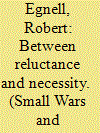

|
|
|
|
|
| Publication |
2008.
|
| Summary/Abstract |
The civil-military interface in peace support operations is changing due to increasingly overlapping tasks, increased military involvement in humanitarian activities, and increased integration of all involved actors, not least through various current strategic concepts. This article not only describes these trends, but also, more importantly, analyses certain consequences in terms of mission effectiveness. The focus of the analysis is the ideas of 'militarisation of humanitarian aid' and the reverse 'humanitarianisation of the military'. The main arguments of this contribution are that the assumptions of increased effectiveness stemming from civil-military integration cannot be taken for granted and that there are harmful consequences stemming from blurring the lines between civilian, humanitarian and military actors. There is, in other words, a need to better specify and explain the causal mechanisms that lead to effectiveness in complex peace support operations.
|
|
|
|
|
|
|
|
|
|
|
|
|
|
|
|
| 2 |
ID:
129958
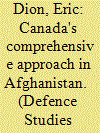

|
|
|
|
|
| Publication |
2014.
|
| Summary/Abstract |
Following a critical review of the extensive literature on the topic of Canada's Comprehensive Approach in Afghanistan, from 2001 to 2011, this article traces the genealogy of the approach, identifies three major contributions as well as three serious limitations. A subsequent qualitative analysis of the content of this literature, as well as a quantitative meta-analysis provide a deeper than ever understanding of the complexity of Canada's so-called Comprehensive Approach and as such, presents the theoretical underpinnings of a pragmatic executive decision-making model for Canada's future engagements, to be developed through further iterations of grounded theory.
|
|
|
|
|
|
|
|
|
|
|
|
|
|
|
|
| 3 |
ID:
186528
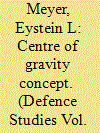

|
|
|
|
|
| Summary/Abstract |
This article applies grounded theory and epistemological, teleological, ontological, and methodological (ETOM) lenses to describe the prevalent contemporary theories of the centre of gravity concept, originated by Carl von Clausewitz. These include the theories of John Warden, Joe Strange & Richard Iron, Antulio Echevarria II, Milan Vego, Dale Eikmeier, and Jacob Barfoed. The article then compares the theories across 14 deduced theoretical aspects and produces a comparison matrix, that can be used as an analytical tool, and discusses implications as guidance for further research and doctrine development. The article argues that the term “centre of gravity” is polluted, and that the application of the term in military planning and doctrines requires careful attention to the specific theory being applied, so that logical consistency and clear, accurate communication is achieved. Alternatively, the concept may be removed from doctrine altogether, renovated with inclusion of a new unpolluted term, or reconstructed with removal of the centre of gravity, leaving a “critical factor analysis” concept behind. This article also provides a level of granularity to the debate about the concept, that renders critics like Paparone & Davis Jr and Zweibelson partly irrelevant and can provide a more nuanced and qualitative basis for future discussion.
|
|
|
|
|
|
|
|
|
|
|
|
|
|
|
|
| 4 |
ID:
108770
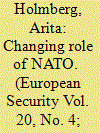

|
|
|
|
|
| Publication |
2011.
|
| Summary/Abstract |
The North Atlantic Treaty Organisation's (NATOs) changing role was debated in the face of the Strategic Concept adopted in late 2010. Two main roles can be identified in the debate; that of NATO as a defence organisation and a security organisation. The article analyses the implications of these roles for security governance and the Alliance's legitimacy - with emphasis on the novelties associated with the role of NATO as a security organisation. This development suggests an increasing need for security governance, something which is reflected in the debate. However, how for instance decision-making and implementation function in a more fragmented environment is unclear. If NATO develops its role as a security organisation new audiences are introduced that determine its appropriateness and the basis of the Alliance's input and output legitimacy changes.
|
|
|
|
|
|
|
|
|
|
|
|
|
|
|
|
| 5 |
ID:
120307
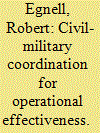

|
|
|
|
|
| Publication |
2013.
|
| Summary/Abstract |
The last decade has witnessed a cascading proliferation of strategic concepts that emphasise the importance of civil-military cooperation, coordination, or integration for effectiveness in complex operations. These efforts nevertheless often lack an appreciation for why, where, and how such integration and coordination should take place to achieve the desired outcomes. This article introduces a new approach to civil-military coordination that incorporates the challenges and possibilities at both the national/strategic level and the tactical level in field of operations. By integrating and coordinating these efforts at the strategic level, this approach allows policymakers to achieve separation of actors and responsibilities in the field of operations. By doing so, the proposed approach seeks to answer more specific questions about when coordination is necessary for effectiveness, what its aims are, what actors need to be involved, and to what extent and at what level of command the actors need to be coordinated.
|
|
|
|
|
|
|
|
|
|
|
|
|
|
|
|
| 6 |
ID:
139097
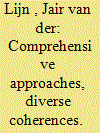

|
|
|
|
|
| Summary/Abstract |
Since 2000, international organisations such as the UN, NATO and the EU, but also countries, have started to apply what has been called the comprehensive approach to crisis management. This article unpacks this comprehensive approach implemented by the Dutch in Uruzgan province, Afghanistan. It first borrows and expands a conceptual framework developed by De Coning and Friis. Subsequently, it maps the different sorts of coherence in the mission by applying the framework. It shows how in practice there was not one single comprehensive approach, but many different forms of interaction between a number of organisational units. Each interaction had its own distinct issues and its own level of coherence. The level of coherence differed depending on the level at which the interaction took place – strategic at headquarters level versus operational at field level – and at what point in the mission it happened – in most cases it moved towards more cohesion.
|
|
|
|
|
|
|
|
|
|
|
|
|
|
|
|
| 7 |
ID:
120304
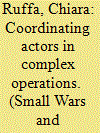

|
|
|
|
|
| Publication |
2013.
|
| Summary/Abstract |
International responses to conflicts and humanitarian emergencies have become more crowded. Not only do traditional actors intervene on a greater scale, such as non-governmental organizations and the military, but new actors such as Private Military Security Companies also play an increasingly important role. These actors often differ in their precise objective and the constituencies they are accountable to. Yet, the practices of these actors in operations are intertwined and many of their tasks overlap. Improved communication and coordination of these actors in complex operations can thus be expected to lead to strong increases in mission effectiveness. This Special Issue provides a conceptual platform to understand and explain under what conditions coordination among these actors occurs. The articles cluster around three themes. A first set focuses on who the actors involved are along a private vs public and military vs civilian divide; a second group of articles assesses experiences of coordination of different actors in the field; finally, a third looks at a plurality of elements that may trigger or hinder coordination.
|
|
|
|
|
|
|
|
|
|
|
|
|
|
|
|
| 8 |
ID:
167458
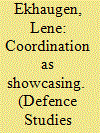

|
|
|
|
|
| Summary/Abstract |
In complex operations such as the interventions in Iraq and Afghanistan, where multiple government ministries are involved in putting together a state’s contributions, the use of national-level coordination bodies has become more widespread. Research has taken for granted that the rationale behind these bodies reflects their declared aim – enhanced coordination as a means to improve mission effectiveness. However, they appear to have had modest effect on coordination. That notwithstanding, they seem to remain popular. This prompts us to ask why such bodies are actually established. This article – based on in-depth interviews and archival records – critically explores the establishment of Norway’s ad hoc, inter-ministerial, political-level Afghanistan Forum. Distinguishing between a structural-instrumental, a cultural-institutional and an environmental perspective from organizational theory to structure the analysis, this article shows that the declared purpose of the forum, inter-ministerial coordination, proved less important than showcasing coordination efforts and keeping the coalition together. In addition, national traditions in handling coordination challenges in the central government apparatus and powerful international reforms helped bring the forum about. This has implications for research on the rationale and effectiveness of these bodies, and also for understanding their policy relevance.
|
|
|
|
|
|
|
|
|
|
|
|
|
|
|
|
| 9 |
ID:
160991


|
|
|
|
|
| Summary/Abstract |
Approximately 470,000 refugees and migrants passed through Slovenian territory between September 2015 and March 2016, creating a crisis that required a great deal of organisational and field work on the part of many governmental and non-governmental institutions. In the social sciences, a discourse on “security versus humanitarian approach” on the refugees and migrant issue appeared; however, the article goes over such a discourse and deals with roles and problems of different institutions – mostly the military – that responded to the crisis. Namely, coping with the crisis was characterised by significant institutional adjustments, difficult co-ordination, and intense public debate. The Slovenian Armed Forces were included in this process as support for Civil Protection and Police. The military’s role followed the military missions defined by the Defence Act; however, the government also proposed some changes to the act that were met with some doubts on the part of the public and different institutions.
|
|
|
|
|
|
|
|
|
|
|
|
|
|
|
|
| 10 |
ID:
109957
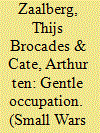

|
|
|
|
|
| Publication |
2012.
|
| Summary/Abstract |
This article examines the so-called 'Dutch approach' to conducting stabilisation operations. The term is mostly used in relation to the mission carried out by the Netherlands armed forces in Afghanistan's Uruzgan province from 2006 to 2010, but actually originates in the Iraqi province of Al Muthanna. Here, a 1350-strong battle group operated from July 2003 until March 2005 as part of the US-led coalition, after which the Dutch forces left Iraq relatively unscathed and self-confident of their ability in dealing with this type of conflict. On the basis of archival research and interviews, the authors unravel the 'Dutch approach' in southern Iraq by tracing its roots and by examining the Dutch operation in the context of the American and British experiences. They argue that despite predominantly effective tactical reflexes and an overall adequately broad interpretation by battle group commanders of a too narrowly defined political mandate, stability in Al Muthanna was conditions-driven rather than the result of a unique and effective approach. The term 'Dutch approach' turned out to be a convenient fabrication which, after the relatively successful mission in Al Muthanna, became increasingly politicised in the run-up to a dangerous new operation in southern Afghanistan.
|
|
|
|
|
|
|
|
|
|
|
|
|
|
|
|
| 11 |
ID:
144937
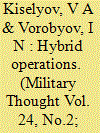

|
|
|
|
|
| Summary/Abstract |
The authors give their view of hybrid operations, a new type of warfare that is actually the annexation of a part of a target country, and take a close look at the basic components of hybrid warfare that have a decisive effect on the conduct of hybrid operations.
|
|
|
|
|
|
|
|
|
|
|
|
|
|
|
|
| 12 |
ID:
120308
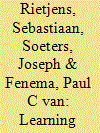

|
|
|
|
|
| Publication |
2013.
|
| Summary/Abstract |
Uruzgan Province is widely seen as one of the few areas where positive developments occurred in Afghanistan's south. A major reason for this success is believed to be the comprehensive approach that was adopted to address the complex and multifaceted nature of problems. This article analyses the coordination between the Dutch military and the wide variety of civil actors that took place during the period 2006-2010 in Uruzgan as this was a key element within the comprehensive approach. Making use of inter-organizational network theory, the article identifies and analyses three dimensions of civil-military coordination: interdependence, (in)coherence of logics and conditions for coordination. Based on these dimensions the article develops a strategic compass that guides military forces in establishing and managing their relationships with civil actors.
|
|
|
|
|
|
|
|
|
|
|
|
|
|
|
|
| 13 |
ID:
168968
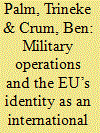

|
|
|
|
|
| Summary/Abstract |
For long, its lack of military means served to single the European Union out as a “civilian” or “normative power”. However, since 2003 twelve EU military operations have been launched. On the basis of a comprehensive analysis of all EU military mission so far, this article seeks to establish how these missions have evolved over time and how they have affected the character of the EU as an international actor. For this purpose, the article outlines four ideal-typical conceptions of the EU's international identity and operationalises them along two underlying dimensions: justification (the purpose of military operations) and policy-embeddedness (the coordination between military means and other foreign policy instruments). Analysing the military operations along these two axes, the article suggests that the EU has been evolving towards a “Liberal Power” identity, as is reflected in a shift from value-based to utility-based justifications, while military operations have at the same time become more embedded in the EU's overall foreign policies.
|
|
|
|
|
|
|
|
|
|
|
|
|
|
|
|
| 14 |
ID:
106199
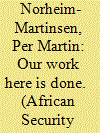

|
|
|
|
|
| Publication |
2011.
|
| Summary/Abstract |
Since the European Union's Organisation Operation Artemis in support of the United Nations mission in the Democratic Republic of Congo (MONUC) in 2003, Africa has become a key area of operations for the EU, an important source of lessons learned, and a test case for a constructive UN-EU partnership. The questions posed in this paper are whether the lessons learned have been the 'right' ones, and whether the hopes that the EU would become a vehicle for a revival of European peacekeeping in Africa have been met. The paper shows that despite initial hopes that it would become an active and responsible peacekeeper, the EU's African venture soon showed signs of strain. Routine claims to success, and a need to prove itself as a potent military actor, have made it hard for the EU to learn the right lessons from these operations and develop relations with the UN. A further problem is that the EU, through its short-term 'bridging operations', subsequently often increases the strain on the UN. Finally, the potential for drawing synergies between both organisations' unique potentials as civil-military actors has not been tapped.
|
|
|
|
|
|
|
|
|
|
|
|
|
|
|
|
| 15 |
ID:
152385
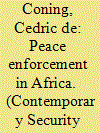

|
|
|
|
|
| Summary/Abstract |
When the United Nations (UN) Security Council needs to authorize a peace enforcement operation in Africa, its partner of choice is the African Union (AU). Africa has developed significant peace operations capacity over the past decade. In addition to deploying eight AU operations, Africa now contributes 50% of all UN peacekeepers. African stability operations, like its mission in Somalia, are often described as peace enforcement operations. In this article, I question whether it is accurate to categorize African stability operations as peace enforcement? I answer the question by considering what the criteria are that are used to differentiate between peace enforcement and peacekeeping operations in the UN context. I then use the peace enforcement criteria to assess whether AU stabilization operations would qualify as peace enforcement operations. In conclusion, I consider the implications of the findings for the strategic partnership between the AU and the UN.
|
|
|
|
|
|
|
|
|
|
|
|
|
|
|
|
| 16 |
ID:
128231
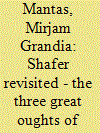

|
|
|
|
|
| Publication |
2013.
|
| Summary/Abstract |
The comprehensive approach, also known as the integrated approach, is foundational to the strategies of the Western countries operating in south Afghanistan. It builds on the same premise as the hearts and minds (HAM) theory: by providing security and basic needs to the population, support is taken away from insurgents. The assumption that a (fragile) state will be able (with support of foreign troops and organisations) to provide basic services, security, and economic prosperity, which was questioned and critiqued by Michael Schafer over two decades ago, is still part of the contemporary concept and seems to remain uncontested. The objective of this article is to test Shafer's claims about the perseverance of what he coined 'the deadly paradigms of counterinsurgency' against the British and Dutch experiences in south Afghanistan starting in 2005.
|
|
|
|
|
|
|
|
|
|
|
|
|
|
|
|
| 17 |
ID:
128236
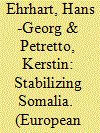

|
|
|
|
|
| Publication |
2014.
|
| Summary/Abstract |
States with limited statehood such as Somalia can cause transnational security challenges. The emergence of an insurgent group with links to Al Qaida and piracy emanating from its coast are cases in point. In this article, we tackle the question of whether the EU's comprehensive approach toward Somalia is working. To do this, we analyze its effectiveness, its legitimacy, and the influence of power by appraising three characteristics of the security governance concept in a critical manner. We conclude that the result is mixed. Even if the EU's comprehensive approach were perfect in a technical sense, it would still face restraints, because any solution has to come from Somali themselves. Not only should they be an integral part of it, they should become the real owners of the state-building process in the first place.
|
|
|
|
|
|
|
|
|
|
|
|
|
|
|
|
| 18 |
ID:
186899
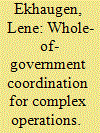

|
|
|
|
|
| Summary/Abstract |
Whole-of-government coordination has produced meagre results if measured against declared aims. However, an assessment of such coordination efforts should include also unstated aims. Based on an in-depth study of the primary high-level coordination body for Norway’s Afghanistan engagement, this article finds that the body was successful in pursuing symbolic politics. Showcasing was an underlying but non-declared aim of the body in question. These findings are significant because they provide an explanation why governments continue to pursue this kind of coordination efforts despite their apparent lack of success. Improved coordination was achieved mostly in terms of information sharing.
|
|
|
|
|
|
|
|
|
|
|
|
|
|
|
|
| 19 |
ID:
143520
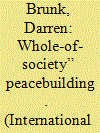

|
|
|
|
|
| Summary/Abstract |
Current best practices in peacebuilding emphasize the importance of integrated or comprehensive approaches that optimize donor state resources through improved coordination and coherence among the security, diplomacy, and development sectors. While these “whole-of-government” approaches have improved donor state engagements in fragile and conflict-affected states in recent years, donor governments have generally failed to effectively engage segments within their home societies that may not be active in peacebuilding activities but that have potential to influence peacebuilding outcomes abroad. A “whole-of-society” approach allows governments to identify and draw from non-traditional actors.
|
|
|
|
|
|
|
|
|
|
|
|
|
|
|
|
| 20 |
ID:
139210
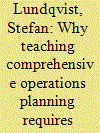

|
|
|
|
|
| Summary/Abstract |
This article argues that the method outlined in NATO’s Comprehensive Operations Planning Directive (COPD) manual is entirely based on systems theory and describes how to apply the principles for managing system change through comprehensive operations projects. Such systems thinking is based on conceptually different principles than traditional military planning methods. Students must therefore be provided with new conceptual tools to understand and handle the complex planning process outlined in the COPD manual. Thereto, they require knowledge of its founding scientific theories to meet academic standards. The concluding message is that military teachers and students must widen their individual mental frames of reference through a transformational learning process to obtain the comprehensive understanding required to fully manage the COPD process. Moreover, they need to prepare for facilitating dialogues in the less mature comprehensive operations planning teams of real-life situations.
|
|
|
|
|
|
|
|
|
|
|
|
|
|
|
|
|
|
|
|
|